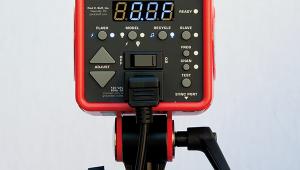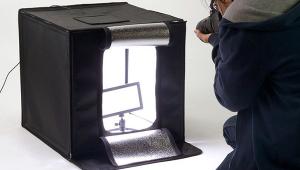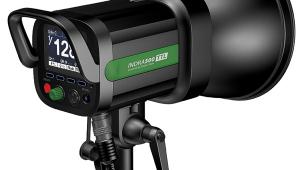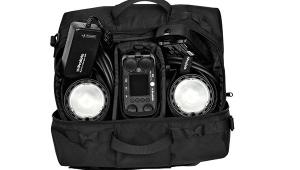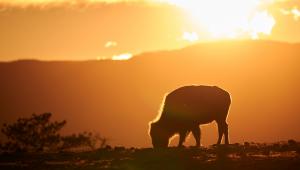Shooting Studio Portraits with One LED Using Fotodiox’s New High-Intensity Light

There are two kinds of portrait photographers: the first likes to shoot with “available light,” by which they mean “every light that’s available.” For some shooters, setting up five lights to make a portrait is just getting started. The second group prefers to use as few light sources as possible because there’s less gear to fiddle with, which translates into more time spent concentrating on the subject. Isn’t that what making a portrait is all about? Using fewer lights is less expensive, reduces setup time, and results in less weight to transport on location. But can you make a portrait with just one light?


The Tools
Continuous light sources are popular with new and aspiring pros because they let you see in real time the lighting effect produced.
LED-based studio lights, like Fotodiox’s Pro High-Intensity LED studio light, do that too without as much heat when compared to other kinds of continuous light sources such as quartz or photoflood. Fotodiox’s studio light is available in either Tungsten or Daylight models and both have a CRI (Color Rendering Index) of 85. While that may earn you a B+ in school, I did my own homework to see what color the Daylight model I tested really delivers. You can see the results of a “before and after” comparison, so judge for yourself. Next, I used a pocket spectrascope to analyze the quality of Fotodiox LEDs and found a smoothly reproduced spectrum with no spikes or missing color bands.
Both Fotodiox models produce an output of 7700 Lux/m or 706 foot-candles and the company claims its LED studio light produces the equivalent of a 600-watt incandescent source. Output is dimmable using Chiclet-style plus and minus controls and a digital display shows the brightness range from zero to 100. If these specifications don’t mean much to you in photographic terms, I used a Gossen Luna-Star F2 meter set at ISO 100 to measure the Daylight model’s maximum output at 10 feet and got an exposure of 1/15 sec at f/2.8. This compares favorably to LED studio lights that I’ve tested costing three times the Fotodiox’s $329.95 price tag.
Diffuser & Mount
The light’s built-in glass diffuser produces soft, even lighting and a rear-mounted fan prevents heat buildup in the monolight-styled housing, permitting longer and more comfortable sessions for subject and photographer. I usually complain about the noise studio light fans produce but this one does its job quietly.
The light has a Bowens S-compatible mount for attaching softboxes, barn doors, and snoots, and comes with a 12-inch reflector along with a “sock” for extra diffusion. Fotodiox offers its own family of light modifiers, including the optional ($109.95) 36x48-inch Pro Softbox that has an internal diffuser that acts like a beauty dish helping spread light internally, before passing through another layer of diffusion material inside the softbox’s frame. This produces soft, even light you can use by itself—no reflector required—for even loosely cropped headshots. The basic form factor of Fotodiox’s Pro High-Intensity LED means you should be able to put it to work in your studio with a short learning curve. So let’s do it.



All Photos © Joe Farace
The Assignment
Setting up the Fotodiox Pro High-Intensity LED light is pretty much like any monolight with the exception of its hefty (5.75 pound) external transformer. The 3.5x5.5x11-inch transformer has an external handle on its longest side and I used an Adorama Pro Super Clamp to attach the transformer to a light stand, making it possible but not necessarily easy—the combination is heavy—to move the Fotodiox LED light around my camera room.
If you’re only going to use one light source, it helps if you have options as far as light modification is concerned. While photographing Danielle Nicole I did a comparison showing the results that can be achieved with and without the diffusion sock attached to the reflector. The 36x48-inch Pro Softbox opens like an inverted umbrella and mounting on the Fotodiox Pro High-Intensity LED is easier than the traditional “sticks-in-a-speed ring” light bank.
One of the basic rules of portrait lighting is that the bigger a light source is, the softer it is and the closer a source is to the subject, the softer it is. The Fotodiox Pro High-Intensity LED with its large softbox mounted is a large and soft light source and you can use it close to the subject—without any reflectors—to produce a true single-source lighting setup that produces a flattering and salable portrait.


The Fotodiox head has an umbrella slot about where you would expect it, although there is no corresponding slot in the reflector for an umbrella to pass through. Perfectionists might want to drill one but the LED light source is recessed so I used it without a reflector for the images you see here that were shot with umbrellas. Working with the Fotodiox Pro High-Intensity LED light and an umbrella in either traditional bounce and shoot-through modes was not much different than using a monolight, with the exception that you could shoot as fast as you can click the shutter because there’s no waiting for a flash to recycle. Using a 60-inch umbrella in shoot-through mode spread enough light to give me the ability to shoot full-length shots.
Before wrapping up my session with Danielle Nicole I made a series of shots with the single light placed behind her, which was more of a challenge because of the possibility of the unit and the number and length of cords getting into the shot. When comparing the exposures shown in the illustrations, keep in mind that all of the images in the Danielle series were made with the Fotodiox Pro High-Intensity LED set at full power.



Fotodiox’s Pro High-Intensity LED light looks and (sorta) acts like a studio monolight and there’s no doubt you can treat it that way for single-source lighting setups. I’m guessing that most portrait photographers will prefer the Daylight model, while video shooters might like the Tungsten model. The two models have one major feature in common: they are both “bang for the buck” LED lighting systems producing lots of light for their cost, and that’s what single-light portraiture is all about.
Glow Grand Softboxes
Glow Grand Softboxes are available in 47-inch ($249.95) and 71-inch ($349.95) sizes and have a parabolic design, creating a light source that’s designed to simulate sunlight. Other Glow softboxes are available in sizes as small as 24 inches, including one for speedlights. The Glow Grand’s bowl reflector combines the strength of a key light while acting as a great reflector. It maximizes the effectiveness of a single light source into direct soft light.
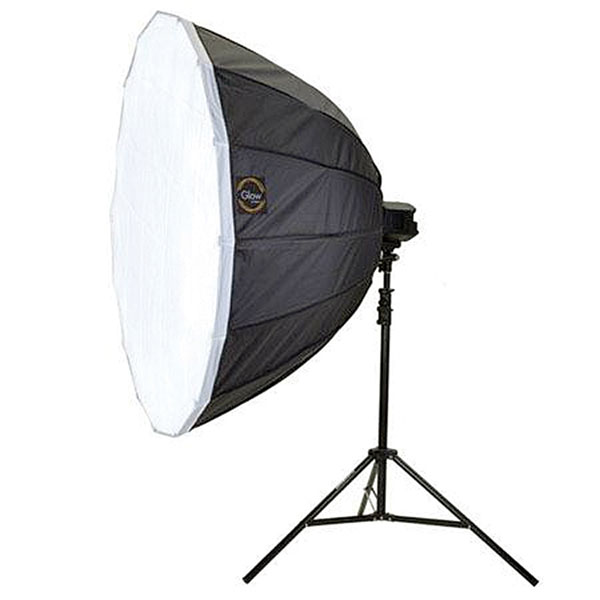


Unless you have a large camera room or shoot on location in large open spaces, the 47-inch Glow Grand Softbox I tested is probably the best all-around choice. The critical ingredients in any softbox are the internal reflective fabric, front diffuser/baffle, and shape of the box itself. Silver-faced fabric lines the softbox’s interior surfaces and adds a crisp quality to the output. The reinforced support rod pockets, seams, and Velcro closures make assembly and set up simple. The 47-inch Glow Grand Softbox, like all of the Glow-R Series Softboxes, features removable internal and external diffusers and comes with a Bowens S-compatible speed ring. There’s even a nice carrying case that holds everything but the speed ring. All of the materials and construction of the Glow Grand Softboxes are high quality, but you have to pay for it. For more information, contact Adorama at www.adorama.com.



For more information and full specs, contact Fotodiox Inc. at www.fotodioxpro.com.
- Log in or register to post comments






